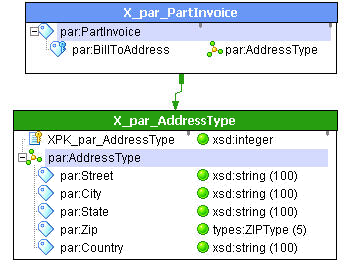PowerCenter
- PowerCenter 10.4.0
- All Products

<xsd:sequence> <xsd:element name="Street" type="xsd:string" /> <xsd:element name= "City" type="xsd:string" /> <xsd:element name="State" type="xsd:string" /> <xsd:element name="Zip" type="types:ZIPType" /> <xsd:element name="Country" type="xsd:string" /> </xsd:sequence> </xsd:complexType> <xsd:complexType name="USAddressType"> <xsd:complexContent> <xsd:extension base="AddressType"> <xsd:sequence> <xsd:element name="PostalCode" type="xsd:string" minOccurs="0"/> <xsd:sequence> </xsd:extension> </xsd:complexContent> </xsd:complexType> <xsd:element name="BillToAddress" type="AddressType" /> <xsd:element name="ShipToAddress" type="USAddressType" />
